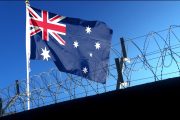
Australia’s nuclear-powered submarine program in association with the United States and the U.K. will cost up to A$368 billion over the next 30 years, a defense official said on Tuesday.
This program is slated to be the country’s largest single defense project in its history.
U.S. President Joe Biden, Australian Prime Minister Anthony Albanese, and U.K. Prime Minister Rishi Sunak disclosed details of a blueprint to supply Australia with nuclear-powered attack submarines to fend off communist China’s naval ascendency in the Indo-Pacific.
Albanese remarked that the project would begin with a A$6 billion investment over the next four years to expand a major submarine base and the country’s submarine shipyards, as well as train skilled workers.
“This will be an Australian sovereign capability — built by Australians, commanded by the Royal Australian Navy and sustained by Australian workers in Australian shipyards,” Albanese declared in a speech in San Diego, California.
“The scale, complexity and economic significance of the investment are akin to the creation of the Australian automotive industry in the post-war period,” he elaborated.
Australia will also supply A$3 billion to expand shipbuilding capacity in the United States and Britain, with most of the money earmarked to accelerate the production of U.S. Virginia-class submarines.
The total cost of the submarine program is estimated to be A$268 billion to A$368 billion by 2055, or about 0.15 percent of Australia’s annual gross domestic product, a defense official said in a statement to Reuters.
This price point entails the cost of building submarines as well as related infrastructure and training. The project is poised to generate 20,000 jobs in Australia over 30 years.
In light of Australia’s declaration, U.S. nuclear-powered submarines will visit Western Australia more often this year, with British submarines making port visits from 2026 onward.
Beginning in 2027, HMAS Stirling, an Australian naval base near Perth, will be host to a rotational presence of U.K. and U.S. nuclear-powered submarines in order to aid in the construction Australia’s submarines.
The new Aukus submarine class is being constructed in Australia and the U.K. because the planned next model of U.S. submarine is too large for Australia, said Dr. John Blaxland, a professor of international security at Australian National University. He deemed the huge cost a “hike in the insurance premium for national security.”
As Australia reboots its historical ties with Britain and the United States, its defense plans also remain connected to its neighbors in Southeast Asia and the Pacific.
“Yes, it’s an eye-watering price tag, but the alternative is an even heavier cost to Australia’s security and sovereignty down the track,” said Australian Strategic Policy Institute executive director Justin Bassi.
Australian Treasurer Jim Chalmers lauded the decision as “a game-changing investment” amid questions from the Australian government on the price tag of the project. Amid rising pressure over the federal budget and prolonged deficits, Chalmers said, “Australia can’t afford not to do this…. It will be worth every cent when it comes to our national security, our national economy.”
Moreover, opposition leader Peter Dutton, who was the Defense Minister when the AUKUS trilateral defense pact was declared in 2021, said he would back the submarine deal “come hell or high water.”
Britain will construct the first SSN-Aukus craft, as the new class of submarines has been labeled. The first completed Australian-built submarine will be unveiled in 2042, and one will be built every three years until the fleet reaches eight.
Australian submarine construction will happen in the state of South Australia, where A$2 billion will be spent on infrastructure, generating 4,000 jobs, with another 5,500 direct shipyard jobs slated to be created when construction reaches its zenith.
The government said that the expected number of jobs was double the workforce expected for a previously abandoned plan to construct French-designed conventional submarines.
The naval base near Perth that will play host to the new submarine fleet is expected to be overhauled at a cost of A$8 billion over 10 years and generate 3,000 jobs, documents and statements published by Australia read.
Meanwhile, Australian Prime Minister Anthony Albanese stated that Australia would have the ultimate say over all decisions entailing its new fleet once it was ready, regardless of the origin of the vessels.
“Australia will absolutely retain our sovereignty, our absolute sovereignty, 100 percent — it is very important,” he said.
Australian Defense Minister Richard Marles added that the nuclear submarines will guarantee peace and stability across the Indo-Pacific, Southeast Asia, and Indian Ocean.
“Clearly, these submarines will have the capability to operate at war, but the true intent of this capability is to provide for the stability and for the peace of our region,” Marles told Parliament.
Under the initial AUKUS deal declared in 2021, the United States and the U.K. agreed to supply Australia with the technological know-how to mobilize nuclear-powered submarines as part of joint efforts to tackle the rising threat posed by China in the Indo-Pacific region.
The U.S. Congress has been briefed several times in recent weeks on the AUKUS deal to rally support for the legal changes required to facilitate technology-transfer issues for the highly classified nuclear propulsion and sonar systems that will be aboard Australia’s new submarines, a congressional source said.
Over the next five years, Australian workers will visit U.S. submarine shipyards to observe and train.
This training will directly boost U.S. submarine production, as there is presently a labor shortage for shipyard workers, the source added.
At present, it is uncertain how Australia’s recent announcement might impact the U.S. Navy’s expectations for its own submarine procurements in coming years.
The U.S. Navy’s 30-year shipbuilding plan unveiled in 2022 forecast submarines being produced at a rate of 1.76 to 2.24 annually and forecast the fleet to increase to between 60 and 69 nuclear attack submarines by 2052, based on the Congressional Research Service.
General Dynamics, which manufactures Virginia-class submarines, has 17 of them in its present backlog, delivering through 2032.
In turn, China has slammed the aforementioned efforts by the Western allies who are mounting pressure on Taiwan and increasing their presence in the contested South China Sea.
Till now, no party to the nuclear Non-Proliferation Treaty other than the five countries the treaty acknowledges as weapons states — the United States, Russia, China, Britain, and France — has nuclear-powered submarines.




